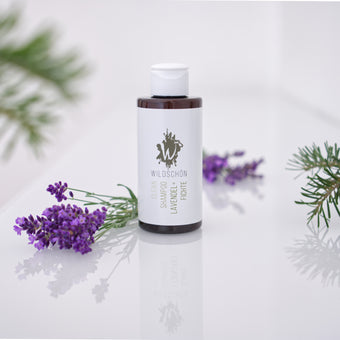Traditional European medicine and natural cosmetics - what does that have to do with each other?
- What is Traditional European Medicine (TEM)?
- Can plants (extracts) have an effect?
- Can the TEM findings be transferred to natural cosmetics?
Whether with olive, agave, chamomile or sage - many cosmetic products advertise the effect of plant extracts. They should provide moisture, soothe the (scalp) skin or repair the hair "from the roots up". Much of this sounds like mere marketing, but there is a kernel of truth, as is so often the case, in the advertising statements of the manufacturers. We are also convinced that the valuable essential oils and plant extracts in our products are able to support and care for your skin and hair. The effectiveness of many plant substances is undisputed: Even various medicines contain e.g. B. ivy or lavender extract or other herbal extracts. Have you ever wondered whether plant extracts in cosmetics and medicines can actually have an effect? In this article you will learn more about it.
Isn't that the thing from China?
If you deal with this question, you will eventually come across the term Traditional European Medicine (TEM). Wait a minute, that means TCM! No, you read that right: T E M. TCM stands for Traditional Chinese Medicine and is more familiar to many than TEM. Because although the M stands for medicine, the term TEM is practically not used in the medical field. Curious? Then just read on, because in this article we will take a closer look at the TEM. If you are now wondering whether we are drifting off a bit and what that has to do with natural cosmetics - we will also look into this question. Here we go! We start again at the beginning with the question:
What actually is Traditional European Medicine (TEM)?
TEM is a generic term for various treatment methods. What these treatment methods have in common is their origin: it is assigned to the European cultural area. At this point it becomes immediately clear where the difference to TCM lies: namely in the geographical origin of the treatment methods. As is so often the case with TEM, there is no uniform definition. On the one hand, this applies to the term itself, because sometimes TEN (Traditional European Naturopathy) or TEH (Traditional European Medicine) is also spoken of. On the other hand, there is also no agreement as to which treatment methods are part of TEM and which are not. However, we will not even get into this discussion, after all, this is not intended to be a theoretical treatise.
Medicine from Hippocrates to today
We'll try to describe it briefly and concisely: TEM can be summarized as oral knowledge about healing methods and in particular medicinal plants, monastic medicine (e.g. Hildegard von Bingen) and Kneipp applications up to homeopathy, anthroposophy or osteopathy. In short: quite a lot! In terms of time, the whole thing is a bit easier. The beginning of the TEM is located with the Greek physician Hippocrates of Kos (approx. 460 - 370 BC). Hippocrates...? Physician…? wasn't there something? Correct! Hippocrates of Kos is credited with the relatively well-known Hippocratic Oath. Some medical professional duties are still based on this oath of the doctors of that time (e.g. to protect the patient from harm or medical confidentiality). So far so good. Aside from the fact that TEM begins with a doctor, is there anything more "medical" about TEM? Or asked differently:
Can plants (extracts) have any effect at all?
That's the exciting question! In the history of medicine and today's medicine, terms such as alternative medicine or complementary medicine are mostly used for the treatment methods of TEM. So TEM is not a "real" medicine? The answer to this question falls back into the realm of definitions and we leave that field to others. This is not to say that TEM is a totally esoteric thing to believe or not to believe. Because especially the knowledge of TEM about healing methods and medicinal plants is essentially classified as "medicinally suitable". In concrete terms, this means that this knowledge is consistent, conclusive and scientifically verifiable (whether it is also scientifically verified is another question). Perhaps you have already noticed that we are slowly approaching the question of what all this has to do with natural cosmetics. Because part of TEM includes knowledge about the effects of medicinal plants (also called phytotherapy). And in natural cosmetics in particular there are many plant-based ingredients - after all, chemistry should be left out here.
Traditionally used plant (extracts) can also have an effect
The already mentioned phytotherapy is not only used in the field of alternative medicine such as homeopathy or Bach flower therapy. There is also an area in conventional medicine that deals with medicinal plants. This is the so-called rational phytotherapy. Here the effects of medicinal plants are examined using scientific methods. If an effect can be detected, the active plant component is extracted and z. B. used as an ingredient in medicines. These so-called phytotherapeutics must also be approved by the Federal Office for Drugs and Medical Devices. In order for them to be reimbursed by the statutory health insurance companies, they must meet the same requirements as other medicinal products in terms of their proof of effectiveness. If a drug does not meet these requirements, it can be approved as a traditional herbal remedy under certain conditions. Sometimes, of course, attempts are made to replace the herbal active ingredient with a chemical substance. Not only can this be cheaper to produce, but it can also make it easier to produce consistent quality and quantity than plant extracts.
Not all medicinal plants are scientifically studied
In short: There is scientifically proven knowledge about the effects of various plants. Conversely, this does not mean that everything else that can be done with medicinal plants is ineffective. Medicinal plants can also have an effect if they are used differently than is the case with herbal medicines. Different can e.g. B. mean: as a complete extract in the tea instead of as an extract. And medicinal plants can also have an effect without this being scientifically proven. This is then the area that falls under the term "traditional", i.e. in the category "treasure of experience". After all, not all plants and their effects are scientifically examined, because research is not an end in itself and must be financed. But you have probably tried one or the other home remedy and maybe even noticed an effect. Now we are at the point where we turn towards natural cosmetics.
Limited transferability of effects to other use cases
Critical people may ask themselves at this point whether the effect of a medicinal plant, e.g. B. for phytotherapeutic agents, can be transferred to cosmetic products at all. This question is justified, because after all, a very special application is being examined in a scientific study. And the result applies without restriction only to this special application. Theoretically, e.g. For example, a separate study should be conducted for each shampoo or cream that contains a herbal ingredient - for each individual ingredient that is said to have an effect. Because every product is composed differently and would be its own application, so to speak. That would not only be a time-consuming and costly affair, but also somewhat oversized. Because it makes a difference how an active ingredient gets into the body. An ingested preparation is metabolized and distributed throughout the body via the bloodstream. If it is not tolerated, it can cause problems in various parts of the body and organs. This is different for externally applied products such as natural cosmetics. They work where they are applied. If an externally applied product is not tolerated, it is usually only seen where it was applied. That's why the requirements for active ingredients are stricter, because they can cause more damage, so to speak.
empirical knowledge about mechanisms of action
But even without your own studies, the effects of medicinal plants can sometimes be transferred to other areas of application. Sage, for example, has been scientifically proven to have an anti-inflammatory and astringent (astringent) effect, even if a manufacturer of food, for example, is only allowed to advertise it within very narrow limits. Gargling with sage tea can still help to relieve inflammation in the mouth and throat. However, the astringent effect in particular is a chemical reaction. This means that a plant substance can also trigger it. In such a case, mechanisms of action can be plausibly transferred without direct proof of effectiveness. With many other effects, however, you have to rely on the wealth of experience of the traditional use of the respective medicinal plant.
Conclusion: Natural cosmetics often refers to the traditional knowledge of TEM
Various application methods are grouped under the generic term TEM. Although it seemed different at first, a small intersection with natural cosmetics has emerged in traditional European medicine: the knowledge of the effects of medicinal plants. And that is partly scientifically proven. But can scientifically proven effects that only apply to a specific application also be transferred to other possible applications? This cannot be confirmed in general. With many active ingredients, however, we rely primarily on the centuries-old wealth of experience of traditional knowledge about medicinal plants. We are convinced: Even if no separate efficacy study has been carried out for each shampoo or cream, active plant ingredients can unfold their effect there. But you don't have to believe us, because the proof of the pudding is in the eating. Simply test our natural products and immerse yourself in the world of medicinal plants - from sage to lavender to grape seed oil.










